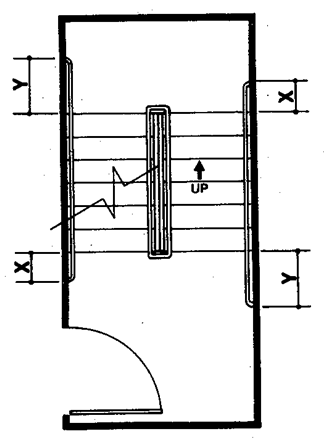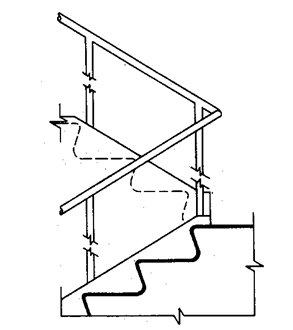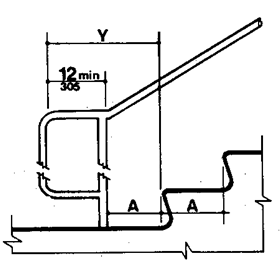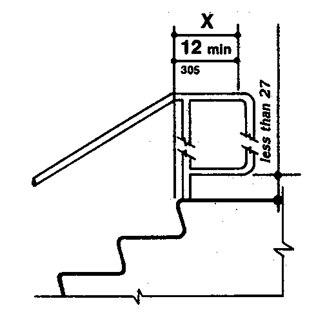4.9 STAIRS.
4.9.1 MINIMUM NUMBER.
Stairs required to be accessible by 4.1 shall comply with 4.9.
4.9.2 TREADS AND RISERS.
On any given flight of stairs, all steps shall have uniform riser heights and uniform tread widths. Stair treads shall be no less than 11 in (280 mm) wide, measured from riser to riser (see Fig. 18(a)). Open risers are not permitted on accessible routes.
Figure 18 Usable Tread Width and Examples of Acceptable Nosings
4.9.3 NOSINGS.
The undersides of nosings shall not be abrupt. The radius of curvature at the leading edge of the tread shall be no greater than 1/2 in (13 mm). Risers shall be sloped or the underside of the nosing shall have an angle not less than 60 degrees from the horizontal. Nosings shall project no more than 1-1/2 in (38 mm) (see Fig. 18).
4.9.4 HANDRAILS.
Stairways shall have handrails at both sides of all stairs. Handrails shall comply with 4.26 and shall have the following features:
(1) Handrails shall be continuous along both sides of stairs. The inside handrail on switchback or dogleg stairs shall always be continuous (see Fig. 19(a) and (b)).
Figure 19
Stair Handrails
Figure 19(a) Plan Note: X is the 12 in minimum handrail extension required at each top riser. Y is the minimum handrail extension of 12 in plus the width of one tread that is required at each bottom riser.
Figure 19(b) Elevation of Center Handrail
(2) If handrails are not continuous, they shall extend at least 12 in (305 mm) beyond the top riser and at least 12 in (305 mm) plus the width of one tread beyond the bottom riser. At the top, the extension shall be parallel with the floor or ground surface. At the bottom, the handrail shall continue to slope for a distance of the width of one tread from the bottom riser; the remainder of the extension shall be horizontal (see Fig. 19(c) and (d)). Handrail extensions shall comply with 4.4.
Figure 19(c) Extension at Bottom of Run Note: Y is the minimum handrail extension of 12 in plus the width of one tread that is required at each bottom riser.
Figure 19(d) Extension at Top of Run Note: X is the 12 in minimum handrail extension required at each top riser.
(3) The clear space between handrails and wall shall be 1-1/2 in (38 mm).
(4) Gripping surfaces shall be uninterrupted by newel posts, other construction elements, or obstructions.
(5) Top of handrail gripping surface shall be mounted between 30 in and 34 in (760 mm and 865 mm) above stair nosings.
(6) Ends of handrails shall be either rounded or returned smoothly to floor, wall, or post.
(7) Handrails shall not rotate within their fittings.
4.9.5 TACTILE WARNINGS AT STAIRS.
(Removed and reserved).
4.9.6 OUTDOOR CONDITIONS.
Outdoor stairs and their approaches shall be designed so that water will not accumulate on walking surfaces.






User Comments/Questions
Add Comment/Question